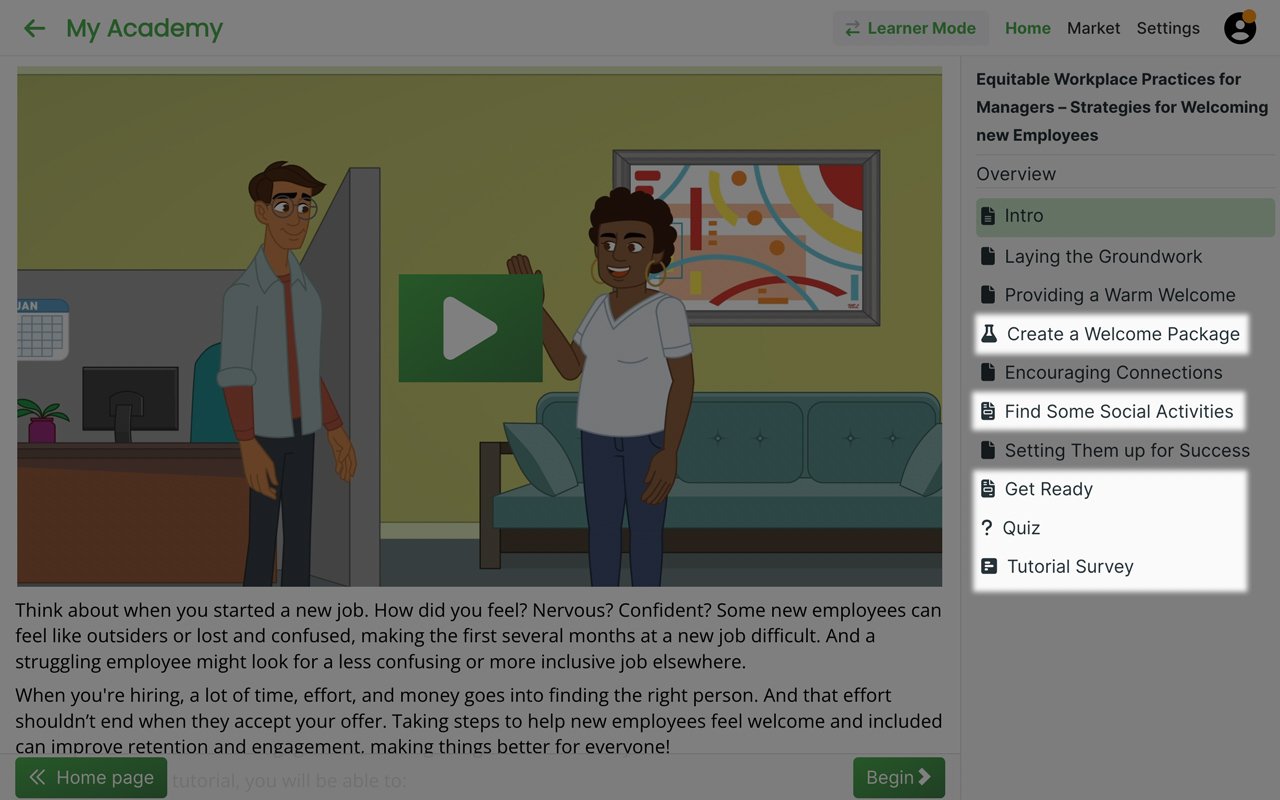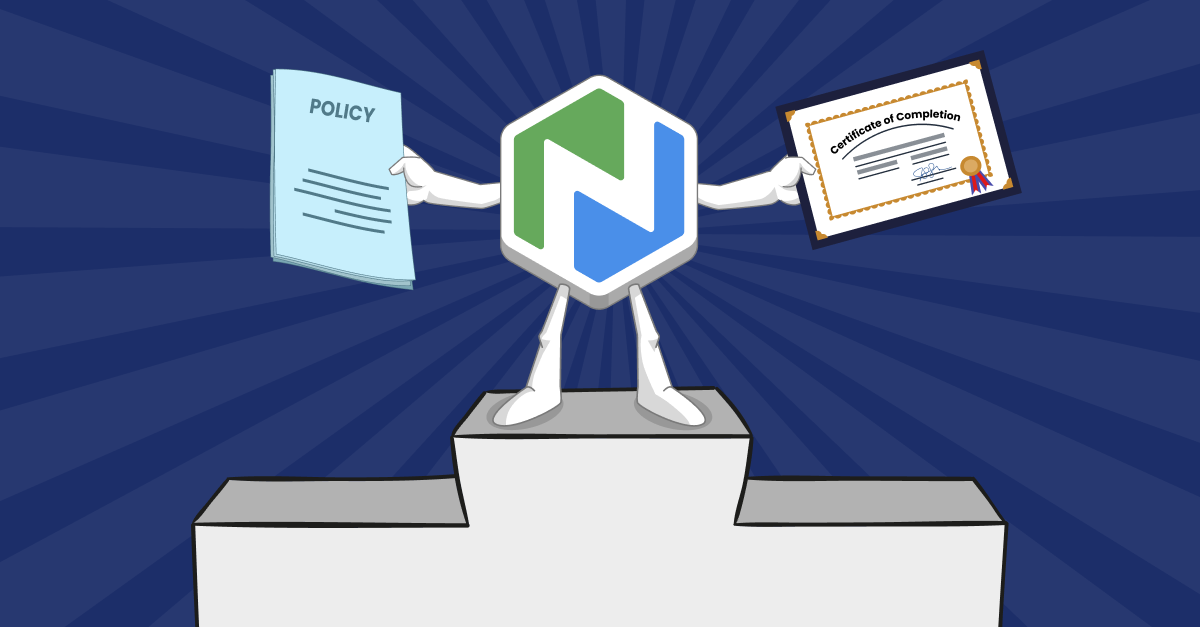6 Really Important Learning Topics for an Equitable Workplace
Discover the key behaviors professional development training should focus on to establish equitable workplace practices.
.png)
Many organizations strive to support DEI in the workplace because they recognize its benefits, including reduced employee turnover, greater innovation, and more.
But, there’s a reason “E” sits between “D” and “I” in DEI—successful diversity and inclusion initiatives depend on equitable workplace practices. You’re not likely to see positive outcomes from building a diverse team unless you take steps to ensure fair treatment, access, and advancement for historically marginalized groups.
People with different backgrounds and beliefs may have conflicting ideas. It’s hard to change people’s hearts and minds, but—if you offer the right learning experiences—you can change behavior.
The Niche Academy learning design team conducts thorough research for every tutorial we write. When we took a deep dive into establishing equitable workplace practices, we identified six important topics every manager training program should include.
Let’s look at key behaviors to focus on.
Welcoming New Employees
 You put a lot of time, effort, and money into finding the right person for a role. And that effort shouldn’t end when they accept your offer. A good onboarding program can improve retention and engagement, making things better for everyone! But, managers may not know how to help new employees feel welcome and included.
You put a lot of time, effort, and money into finding the right person for a role. And that effort shouldn’t end when they accept your offer. A good onboarding program can improve retention and engagement, making things better for everyone! But, managers may not know how to help new employees feel welcome and included.
For successful onboarding, managers need to know how to:
- Lay the groundwork for a good experience before a new hire’s start date. Helping new employees feel welcome and valued should begin as soon as they accept your offer.
- Provide a warm welcome. Making a good impression sets the tone of a working relationship. It’s important to avoid boring or overwhelming new employees on their first day/week.
- Encourage connections. Finding ways for new employees to connect with coworkers can help them feel less like outsiders.
- Set new employees up for success. Giving new employees easy ways to contribute immediately can help them feel like they are part of the team.
Seeing Employees as Humans
 Employees are often seen as data, or a means to an end, making people feel like their manager doesn’t care about them. Sometimes, employees are expected to work extra hours or always be on call, causing them to feel overwhelmed and unsupported. As stress levels rise, you are likely to see lower engagement, poor performance, and higher turnover.
Employees are often seen as data, or a means to an end, making people feel like their manager doesn’t care about them. Sometimes, employees are expected to work extra hours or always be on call, causing them to feel overwhelmed and unsupported. As stress levels rise, you are likely to see lower engagement, poor performance, and higher turnover.
Organizations that meet basic human needs see greater success. Managers may need to learn habits that help their team feel respected, cared for, connected, and supported. Training should focus on ways to:
- Build relationships with employees. Everyone wants a sense of dignity and to feel connected with like-minded people.
- Help employees find meaning in their work. Without a sense of purpose, employees can feel like their efforts don’t matter, which is demotivating.
- Empower employees. True teamwork—the kind that inspires new ideas—happens when people feel a sense of control and ownership.
- Acknowledge each team member’s contributions. Employees who feel valued for their efforts and achievements are more likely to enjoy their work.
Striving for Fairness in Responsibilities
 It can be hard for managers to balance team member responsibilities fairly. Sometimes, it’s easier to assign important tasks to a person with more experience, but doing so prevents new team members from growing. And, people who are given too much work might get sick from the stress, while their coworkers may feel they are missing opportunities.
It can be hard for managers to balance team member responsibilities fairly. Sometimes, it’s easier to assign important tasks to a person with more experience, but doing so prevents new team members from growing. And, people who are given too much work might get sick from the stress, while their coworkers may feel they are missing opportunities.
Knowing how to manage responsibilities fairly can help managers avoid these problems and improve their team’s performance. Managers should learn how to:
- Plan balanced workloads. Taking time to consider workloads, assess situations, and prioritize tasks can help reduce employee stress and burnout.
- Assign work fairly. Matching task requirements with team member’s skills, interests, and personalities can make work more enjoyable.
- Continue to monitor workloads. Balancing workloads is ongoing and requires flexibility. Staying in close contact with your team—without micromanaging—can help you address problems when they arise.
Establishing Explicit Expectations
 Since everyone has a different frame of reference based on their race, gender, age, culture, experiences, and perspectives, the chances for misunderstandings in diverse workplaces are high. Details that seem obvious to one person may not be clear to another. And the stress and frustration caused by unclear expectations can lead to poor performance, conflict, and unfair dismissals.
Since everyone has a different frame of reference based on their race, gender, age, culture, experiences, and perspectives, the chances for misunderstandings in diverse workplaces are high. Details that seem obvious to one person may not be clear to another. And the stress and frustration caused by unclear expectations can lead to poor performance, conflict, and unfair dismissals.
Knowing how to establish explicit expectations—that everyone understands—can eliminate confusion and help teams be more engaged and successful. Training should cover:
- Types of expectations. Recognizing the difference between unclear/unrealistic and clear/realistic expectations is the first step in establishing explicit expectations.
- Areas of expectations. Knowing the different areas of expectations—such as performance, communication, and organizational culture—tells you where clear guidance is needed.
- Steps for setting explicit expectations. Following a specific procedure helps ensure clear communication and consistency.
Guiding Effective Conversations
 Ideally, everyone should feel like they can speak honestly and share constructive feedback in the workplace. But, some employees might be afraid to speak up. Others might be excluded from conversations because of their differences. And these missing voices can lead to more than just missed opportunities. People who feel ignored or like they don’t matter are less likely to care about their work.
Ideally, everyone should feel like they can speak honestly and share constructive feedback in the workplace. But, some employees might be afraid to speak up. Others might be excluded from conversations because of their differences. And these missing voices can lead to more than just missed opportunities. People who feel ignored or like they don’t matter are less likely to care about their work.
Managers need to ensure all voices are heard. Training should show them how to:
- Set the stage. It’s important to establish a safe environment where everyone feels encouraged to participate in discussions.
- Create structure. Whether you are guiding a one-on-one or team meeting, having a clear agenda keeps the conversation on track.
- Model good skills. Modeling good communication skills shows employees how to participate in effective conversations.
- Set the tone and pace. With proper guidance, a conversation’s outcomes should reflect the perspectives of your entire team.
- Manage challenges. Establishing ground rules and maintaining boundaries for acceptable behavior help keep conversations productive.
Creating Feedback Loops
 Creating an equitable workplace—where everyone has the chance to succeed and be heard—depends on continuous feedback, also called feedback loops.
Creating an equitable workplace—where everyone has the chance to succeed and be heard—depends on continuous feedback, also called feedback loops.
A loop happens when information is shared freely, analyzed, acted upon, reviewed, and so on. The repetitive process is often compared to a thermostat constantly checking the temperature of a room and making adjustments as needed. When used correctly, feedback loops help employees feel valued, increasing their engagement and desire to improve.
To create good feedback loops, managers need to know how to:
- Start effective feedback. Meeting regularly, addressing concerns when they arise, and encouraging two-way communication help ensure employees have a chance to improve.
- Seek honest feedback. Using different methods for collecting honest feedback can provide important insights.
- Analyze feedback data. Knowing how to look for trends or patterns can help you see where action is needed.
- Close the loop. Taking action on feedback and collecting new information loops you back to the beginning of the feedback process and helps ensure continued growth and improvement.
Establishing an Equitable Workplace
Learning opportunities centered around the preceding behaviors can help you build an equitable workplace supporting diversity and inclusion.
The Niche Academy Equitable Workplace Practices tutorial series offers engaging content on these topics. Learners can watch quick videos…
 Or scan easy-to-read text.
Or scan easy-to-read text.
 And perhaps more importantly, each tutorial includes activities that allow learners to practice and implement new behaviors.
And perhaps more importantly, each tutorial includes activities that allow learners to practice and implement new behaviors.
 The added benefit of these activities is they provide a useful way to measure learning engagement and progress with Niche Academy’s report tools.
The added benefit of these activities is they provide a useful way to measure learning engagement and progress with Niche Academy’s report tools.
We put the time and effort into creating quality, measurable learning experiences, so you don’t have to. But, you can customize our tutorials, adding or subtracting content and activities to best meet your learners’ needs and organizational goals.
Schedule a free consultation to learn more about our Equitable Workplace Practices series and how Niche Academy makes professional development training easier.
.png)
.png)
.png)

.png)
.png)
.png)

.png)
.png)

.png)